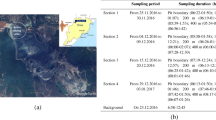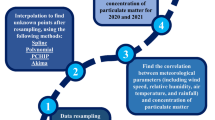Abstract
Particulate matter (PM) is a major pollutant in and around opencast mine areas. The problem of degradation of air quality due to opencast mine is more severe than those in underground mine. Prediction of dust concentration must be known to implement control strategies and techniques to control air quality degradation in the workplace environment. Limited studies have reported the dispersion profile and travel time of PM between the benches inside the mine. In this paper, PM concentration has been measured and modeled in Malanjkhand Copper Project (MCP), which is one of the deepest opencast copper mines in India. Meteorological parameters (wind speed, temperature, relative humidity) and PM concentration in seven size ranges (i.e., PM0.23–0.3, PM0.3–0.4, PM0.4–0.5, PM0.5–0.65, PM0.65–0.8, PM0.8–1, and PM1–1.6) have been measured for 8 days. The results of the field study provide an understanding of the dispersion of the PM generated due to mining activities. This research work presents an approach to assess the exposure of enhanced level of PM concentration on mine workers and its variation with depth. The correlations study shows that concentration of PM during its travel from source to surface is associated with depth. Empirical equations are developed to represent relationships between concentrations of PM and depth. Artificial neural network (ANN) model showing the relationship between PM concentration and meteorological parameters has been developed. The performance of the ANN model is evaluated in terms of the correlation coefficient between the real and the forecasted data. The results show strong agreement between the experimental data and the modeled output. The findings of this work are important in understanding fine PM variation inside the mine at the workplace and the associated exposure of mine workers.











Similar content being viewed by others
Abbreviations
- ANN:
-
Artificial neural network
- HCL:
-
Hindustan copper limited
- MCP:
-
Malanjkhand Copper Project
- mRL:
-
Meter reduced levels
- MSE:
-
Mean square error
- PM:
-
Particulate matter
- RL:
-
Reduced levels
- RMSE:
-
Root-mean-square error
- SOS:
-
Sum of squares
References
Anderson JD (1995) Computational fluid dynamics: the basics with applications. McGraw-Hill, New York
Aneja VP, Isherwood A, Morgan P (2012) Characterization of particulate matter (PM10) related to surface coal mining operations in Appalachia. Atmos Environ 54:496–501
Alekseev KPG, Seixas JM (2002) Forecasting the air transport demand for passengers with neural modelling. Proceedings of the VII Brazilian Symposium on Neural Networks (SBRN), November 11–14, 2002. Pernambuco, Brazil, IEEE 86:–91
Baxter CW, Stanley SJ, Zhang Q, Smith DW (2002) Developing artificial neural network models of water treatment processes: a guide for utilities. J Environ Engg Sci 1:201–211
Blocken B, Stathopoulos T, Carmeliet J (2007) CFD simulation of the atmospheric boundary layer: wall function problems. Atmos Environ 41:238–252
Bose NK, Liang P (1998) Neural network fundamentals with graphs, Algorithms and Applications, New Delhi, Tata McGraw-Hill
Juang HC, Chen CJ (1999) CPT-based liquefaction evaluation using artificial neural networks. Computer-Aided Civil Infrastructure Engg 14:221–229
Chakraborty MK, Ahmad M, Singh RS, Pal D, Bandopadhyay C, Chaulya SK (2002) Determination of the emission rate from various open-cast mining operations. Environ Model Soft 17:467–480
Chowdhary KK (1977) An experimental and theoretical investigation of turbulent separated reattached and redeveloped flows with transverse rectangular cavities. [Ph.D. thesis]. Indian Institute of Technology Delhi, New Delhi
Cohn RD, Eder BK, Leduc SK, Dennis RL (2001) Development of an aggregation and episode selection scheme to support the models-3 community multiscale air quality model. J Appl Meteo 40:210–228
Colard S, O’Connell G, Verron T, Cahours X, Pritchard JD (2015) Electronic cigarettes and indoor air quality: a simple approach to modeling potential bystander exposures to nicotine. Int J Environ Res Public Health 12(1):282–299
Cooper CD, Alley FC (2014) Chapter 3: particulate matter. Air pollution control—a design approach (4th edition). Waveland Press Inc., Illinois, p. 126
Dubey B, Pal AK, Singh G (2012) Trace metal composition of airborne particulate matter in the coal mining and non-mining areas of Dhanbad Region, Jharkhand, India. Atmos Pollut Res 3:238–246
El-Shafie A, Noureldin A (2011) Generalized versus non-generalized neural network model for multi-lead inflow forecasting at Aswan High Dam. Hydrol Earth Syst Sci 15:841–858
Gautam S, Kumar P, Patra AK (2015) Occupational exposure to particulate matter in three Indian opencast mines. Air Qual Atmos Health. doi:10.1007/s11869-014-0311-6
Gautam S, Patra AK (2015) Dispersion of particulate matter generated at higher depths in opencast mines. Environ Tech Innov 3:11–27
Ghose MK, Majee SR (2001) Air pollution caused by opencast mining and its abatement measures in India. J Environ Manag 63(2):193–202
Goyal R, Kumar P (2013) Indoor–outdoor concentrations of particulate matter in nine microenvironments of a mixed used commercial building in megacity Delhi. Air Qual Atmos Health 6:747–757
GRIMM (2010) Operation manual of Portable Laser Aerosol spectrometer and dust monitor (Model 1.108/1.109). GRIMM Aerosol Technik GmbH & Co. KG, Ainring, Germany
Hendryx M (2009) Mortality from heart, respiratory, and kidney disease in coal mining areas of Appalachia. Int Arch Occup Environ Health 82:243–249
Kakosimos KE, Assael MJ, LioumbasJS SAS (2011) Atmospheric dispersion modelling of the fugitive particulate matter from overburden dumps with numerical and integral models. Atmos Pollut Res 2:24–33
Kassomenos P, Petrakis M, Sarigiannis D, Gotti A, Karakitsios S (2011) Identifying the contribution of physical and chemical stressors to the daily number of hospital admissions implementing an artificial neural network model. Air Qual Atmos Health 4:263–272
Kumar A, Goyal P (2013) Forecasting of air quality index in Delhi using neural network based on principal component analysis. Pure Appl Geophy 170:711–722
Kumar P, Ketzel M, Vardoulakis S, Pirjola L, Britter R (2011) Dynamics and dispersion modelling of nanoparticles from road traffic in the urban atmospheric environment—a review. J Aero Sci 42:580–603
Lal B, Tripathy SS (2012) Prediction of dust concentration in open cast coal mine using artificial neural network. Atmos Pollut Res 3:211–218
Lu WZ, Wang WJ, Wang XK, Xu ZB, Leung AYT (2003) Using improved neural network model to analyze RSP, NOx and NO2 levels in urban air in Mong Kok, Hong Kong. Environ Monit Assess 87:235–254
Marrugo-Negrete JL, Urango-Cardenas ID, Núñez SMB, Díez S (2014) Atmospheric deposition of heavy metals in the mining area of the San Jorge river basin, Colombia. Air Qual Atmos Health 7:577–588
Masters GM (1998) Chapter 7: Air pollution. Introduction to environmental engineering and science (2nd edition). Prentice Hall of India, New Delhi, pp. 392–405
Nagendra SMS, Khare M (2004) Artificial neural network based line source models for vehicular exhaust emission predictions of an urban roadway. Transportation Resea Part D: Trans Environ 9(3):199–208
Onder M, Yigit E (2009) Assessment of respirable dust exposures in an opencast coal mine. Environ Monit Assess 152:393–401
Pandey B, Agrawal M, Singh S (2014) Assessment of air pollution around coal mining area: emphasizing on spatial distributions, seasonal variations and heavy metals, using cluster and principal component analysis. Atmos Pollut Res 5:79–86
Peng X, Lu GR (1995) Physical modeling of natural wind and its guide in a large open pit mine. J Wind Engg Indu Aero 54-55:473–481
Pless-Mulloli T, Howel D, Prince H (2001) Prevalence of asthma and other respiratory symptoms in children living near and away from opencast coal mining sites. Int J Epide 30(3):556–563
Reggente M, Peters J, Theunis J, Poppel MV, Kumar P, De Baets B (2014) Prediction of ultrafine particle number concentration in urban environments by means of Gaussian process regression based on measurements of oxides of nitrogen. Environ Model Soft 61:135–150
Richardson LF (1926) Atmospheric diffusion shown on a distance-neighbour graph. Proceedings of the Royal Society of London. Series A 110:709–737
Guttikunda SK, Kopakka RV (2014) Source emissions and health impacts of urban air pollution in Hyderabad, India. Air Qual Atmos Health 7(2):195–207
Sharma P, Sharma P, Jain S, Kumar P (2013) A response to discussion on “An integrated statistical approach for evaluating the exceedence of criteria pollutants in the ambient air of megacity Delhi”. Atmos Environ 71:413–414
Skön JP, Johansson M, Raatikainen M, Leiviskä K, Kolehmainen M (2012) Modelling indoor air carbon dioxide (CO2) concentration using neural network. World Academy of Science Eng Technol 61:879–883
Spectrum (2010) Operation manual of Watchdog 2000 series Portable Weather Station. Spectrum Technologies, Inc., USA
Tecer LH, Suren P, Alagha O, Karaca F, Tuncel G (2008) Effect of meteorological parameters on fine and coarse particulate matter mass concentration in a coal mining area in Zonguldak, Turkey. J Air Waste Manage Assoc 58:543–552
Vardoulakis S, Fisher BEA, Pericleous K, Gonzalez-Flesca N (2003) Modelling air quality in street canyons: a review. Atmos Environ 37:155–182
Viotti P, Liuti G, Genova PD (2002) Atmospheric urban pollution: application of an artificial neural network (ANN) to the city of Perugia. Ecolog Model 148:27–46
Zhang X, Chen W, Ma C, Zhan S (2013) Modeling particulate matter emissions during mineral loading process under weak wind simulation. Sci Tot Environ 449:168–173
Acknowledgments
The authors acknowledge Indian Institute of Technology Kharagpur, India, for funding the research under ISIRD grant. Support of the General Manager of the Malanjkhand Copper Project of Hindustan Copper Limited in providing necessary facilities for conducting the field study is duly acknowledged.
Author information
Authors and Affiliations
Corresponding author
Rights and permissions
About this article
Cite this article
Patra, A.K., Gautam, S., Majumdar, S. et al. Prediction of particulate matter concentration profile in an opencast copper mine in India using an artificial neural network model. Air Qual Atmos Health 9, 697–711 (2016). https://doi.org/10.1007/s11869-015-0369-9
Received:
Accepted:
Published:
Issue Date:
DOI: https://doi.org/10.1007/s11869-015-0369-9




